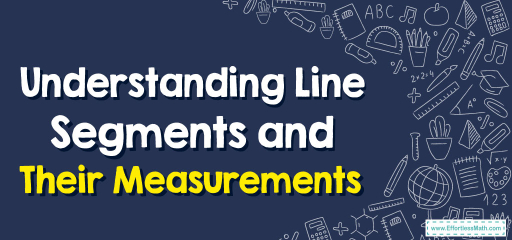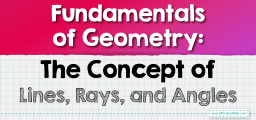Understanding Line Segments and Their Measurements
In the vast landscape of geometry, line segments are the bridges that connect distinct points. They are not infinite like lines but have definitive starting and ending points. Line segments are fundamental in understanding more elaborate shapes and structures in geometry. In this piece, we shall dissect the properties of line segments and delve into the techniques of their measurement, illuminating a path for deeper geometric explorations.

Step-by-step Guide: Line Segments and Measurements
Line Segment:
A line segment is a part of a line that has two defined endpoints. Unlike lines that extend infinitely in both directions, a line segment has a distinct beginning and end. It comprises countless points, including its endpoints.
Example: Line segment \(AB\) is represented by the two endpoints \(A\) and \(B\).
Measurement of Line Segment:
The length of a line segment is a measure of the distance between its two endpoints. This measurement is typically done with the help of a ruler or a digital tool, depending on the context. The length is always a non-negative value and is commonly represented in units like centimeters, meters, inches, etc.
Example: If line segment \(CD\) measures \(5\) centimeters, we write it as \(CD = 5 \text{cm}\).
Examples
Example 1:
If you have a line segment \(EF\) with point \(G\) lying between \(E\) and \(F\), and \(EG = 2 \text{cm}\) while \(GF = 3 \text{cm}\), what is the length of line segment \(EF\)?
Solution:
The total length of line segment \(EF\) is the sum of \(EG\) and \(GF\).
Thus, \(EF = EG + GF\).
Given \(EG = 2 \text{cm}\) and \(GF = 3 \text{cm}\), \(EF = 2 \text{cm} + 3 \text{cm} = 5 \text{cm}\).
So, \(EF = 5 \text{cm}\).
Example 2:
Given a line segment \(HI\) of length \(8 \text{cm}\) and a point \(J\) lying on it such that \(HJ = 3 \text{cm}\), determine the length of segment \(JI\).
Solution:
To find \(JI\), subtract the length of \(HJ\) from \(HI\).
Given \(HI = 8 \text{cm}\) and \(HJ = 3 \text{cm}\), \(JI = HI – HJ\). \(JI = 8 \text{cm} – 3 \text{cm} = 5 \text{cm}\).
So, \(JI = 5 \text{cm}\).
Practice Questions:
- If line segment \(KL\) is \(10 \text{cm}\) and \(KM\) is \(4 \text{cm}\), with \(M\) lying between \(K\) and \(L\), what is the length of \(ML\)?
- Line segment \(VW\) is \(18 \text{cm}\). If \(VX\) is \(7 \text{cm}\) with \(X\) lying between \(V\) and \(W\), what is the length of \(XW\)?
- Line segment \(EG\) is \(24 \text{cm}\). If point \(G\) divides \(EF\) such that \(FG = 9 \text{cm}\), determine the length of \(EF\).

Answers:
- \(ML = 6 \text{cm}\), since the segment is the remainder after subtracting \(KM\) from \(KL\).
- \(XW = 11 \text{cm}\), since the segment is the remainder after subtracting \(VX\) from \(VW\).
- \(EF = 15 \text{cm}\), which is the sum of the total length of \(EG\) and segment \(FG\).
Related to This Article
More math articles
- What Kind of Math Is on the TASC Test?
- 7th Grade K-PREP Math Worksheets: FREE & Printable
- Algebra Puzzle – Challenge 57
- How to Identify Characteristics of Quadratic Functions: Graphs
- Top 10 6th Grade MCAS Math Practice Questions
- Spinning the Numbers: The Hidden Math Inside Slot Games
- A Complete Explanation of the Continuity over an Interval
- How to Unlock the Secrets of Success: “ISEE Upper Level Math for Beginners” Solution Guide
- Algebra Puzzle – Challenge 33
- Bеѕt Grарhing Cаlсulаtоrѕ for Math Tеасhеrѕ
























What people say about "Understanding Line Segments and Their Measurements - Effortless Math: We Help Students Learn to LOVE Mathematics"?
No one replied yet.